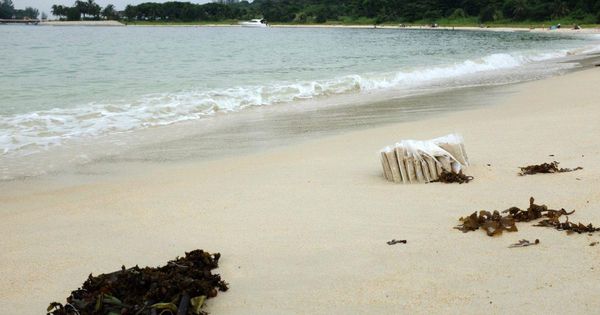
Bacteria living on microplastic pollution in marine environments include a number of pathogenic species as well as a few that might be helpful
Plastic rubbish strewn on the beach, Lazarus Island, Singapore. Lazarus Island was one of the field sites where microplastics were collected for this study.
(Credit: Jnzl / CC BY 2.0) Jnzl via a Creative Commons license
A diversity of bacteria have been discovered living on microplastics collected from Singapore’s beaches and coastal regions, including some that are pathogenic to humans, according to a team of marine researchers. The scientists, who are with the National University of Singapore (NUS), determined that the pathogenic bacteria can cause a variety of damages, ranging from coral bleaching to infecting open wounds. But along with these harmful microbes, the researchers also discovered some potentially useful bacteria, including a few that can biodegrade oil and plastic trash.
“Microplastics form a large proportion of plastic pollution in marine environments,” said marine scientist Sandric Leong, a Senior Research Fellow at the NUS Tropical Marine Science Institute (TMSI), who was the senior author of the newly-published study (ref).
Microplastics — tiny pieces of plastic that range in size from the size of a grain of sand up to a small pebble — are prevalent aquatic pollutants in freshwater and marine waterways, both those that are polluted and those that appear pristine (i.e.; ref & ref).
As a new type of habitat, microplastics are indeed special: there are currently more than 150 million tons of plastics in the ocean, making them exceptionally common. Plastics make great little habitats because they are buoyant and nearly immortal, taking tens of thousands of years to degrade — and even longer in the cooler temperatures of aquatic environments, which slow the rate of degradation from that for terrestrial plastic pollution.
There is so much that is still not known about marine plastic pollution. For example, scientists only recently discovered that marine plastics often smell like food (ref), and this may trick a wide variety of marine species into eating them.
“Marine organisms may consume bits of microplastics unintentionally, and this could lead to the accumulation and subsequent transfer of marine pathogens in the food chain,” Dr. Leong said.
Plastics have been found inside the bodies of the smallest zooplankton to the largest whales, where they wreak all sorts of havoc, from concentrating organic pollutants and hormones that are absorbed by plastics, to starvation, or death from intestinal blockage or choking.
Plastic pollutants are everywhere, but we still don’t know much about them
Despite their ubiquity, the sorts of microbes that dwell on the surfaces of microplastics have never been studied before, particularly on plastic fragments retrieved from tropical waters.
Marine scientist, Emily Curren, a doctoral student at National University of Singapore, examines microplastic samples collected from coastal areas of Singapore.
(Credit: National University of Singapore.)National University of Singapore
To get a better idea of the sorts of microbial communities that live on marine plastic pollutants, Dr. Leong and Emily Curren, a PhD student with the NUS Faculty of Science, collected microplastics from the beaches and coastal regions of Singapore during six months between April and July 2018. Dr. Leong and Ms. Curren then examined 275 microplastic particles salvaged from three beaches along Singapore’s coast, including Lazarus Island, Sembawang Beach, and Changi Beach. They subjected all the collected microplastics to high throughput sequencing of 16S rRNAs and used these sequences to identify more than 400 bacterial species in total.
Graphical Abstract: Emily Curren, and Sandric Chee Yew Leong (2019). Profiles of bacterial assemblages from microplastics of tropical coastal environments, Science of The Total Environment, 655:313–320
(doi:10.1016/j.scitotenv.2018.11.250)doi:10.1016/j.scitotenv.2018.11.250
Plastic surfaces provide homes for a rich assemblage of microbial communities
Amongst the bacterial species that Dr. Leong and Ms. Curren identified were some pathogenic microbes. For example, they found sequences from the bacteria, Photobacterium rosenbergii, a bioluminescent bacterium that is often associated with coral bleaching and disease. This discovery was important since this microbe could potentially sabotage ongoing coral reef conservation and marine habitat restoration efforts in the Singapore Strait.
Ms. Curren and Dr. Leong also found DNA sequences from some marine Vibrio species, a major cause of wound infections in humans, as well as Arcobacter species, known to cause gastroenteritis in humans.
“As the microplastics we studied were collected from locations easily accessible to the public and in areas widely used for recreation, the identification of potentially pathogenic bacteria would be important in preventing the spread of diseases,” Ms. Curren elaborated.
But Ms. Curren and Dr. Leong didn’t discover all bad news: they also identified a few bacteria that might be beneficial. For example, they discovered DNA sequences from a variety of Erythrobacter species, which are capable of degrading plastic, and Pseudomonas veronii, which has been used to help clean up oil spills.
“Given the predicted increase in plastic waste contamination in oceans, the discovery of such bacteria provides important nature-friendly alternatives for the mitigation of plastic pollution and toxic pollutants such as hydrocarbons,” Ms. Curren pointed out.
This research shows that microplastics provide a special habitat for a variety of bacteria. But it raises some questions: Where did these microbes come from? Could these microbial hitch-hikers threaten existing native bacterial communities? If so, what may be the consequences if any of these bacteria become established? This research adds insights to the mounting body of evidence that the global community must take active measures now to address marine plastic pollution, before it is too late.
“[U]nderstanding the distribution of microplastics and identifying the organisms attached to them are crucial steps in managing the plastic pollution on a national and global scale,” Dr. Leong said.
Source:
Emily Curren, and Sandric Chee Yew Leong (2019). Profiles of bacterial assemblages from microplastics of tropical coastal environments, Science of The Total Environment, 655:313–320 | doi:10.1016/j.scitotenv.2018.11.250
Pathogenic Bacteria Found On Microplastics Retrieved From Singapore’s Beaches | @GrrlScientist
